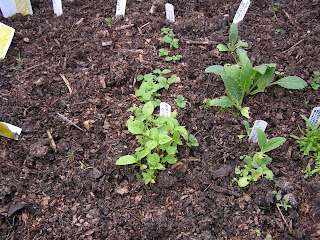As you can see the cucurbit beds are doing quite nicely. They needed a dressing with bonemeal (£27 for 25kg I was shocked) and wood ash because some off the courgettes looked a bit off color but everything looks pretty good now.
Here's one of the watermelons
Unfortunately it seems the mulch beds have been a complete failure as compared with the dug beds
I've started digging all the mulch beds. I can't afford to take years to get these productive. I'm planting marigolds, sage, russian tarragon, japanese catmint, catmint, thyme, coriander, basil and other things like chives and garlic chives throughout the beds. Legumes are coplanted with everything but alliums.
As so many of the things in the mulch beds have failed I've scrapped the documentation I was going to do on the vegetables I'm growing.
Once I have the problems ironed out I'll keep track of that again.

The herb garden has gone berserk and I think it's a wonderful jungle, that's the milk thistle
I thought I'd say a little bit about the forest garden. I've been planting cider apples, a couple of pears (One of which was killed by the deer. I had to
bridge graft one of the apples as it was completely ring barked. I took of a couple of twigs from the tree long enough to cover the gap and got to it with my grafting tape.)
The tree dosn't look too bad.)
There are a couple of
Albizia julibrissin , three Honey locusts
Gleditsia triacanthos a load of gooseberries and some named cobs. There are also a few cherry plums.
For later addition I'm growing a lot of the other plants for the forest garden in the polytunnel garden. The above is the American ground nut
Apios Americana I'll have enough of them this year to risk putting some into the garden. They fix nitrogen as well as being a useful food.
Watering is the main chore at the moment but it looks like it might rain today.
 TThat's Henry. I named him because I don't intend to eat him. I got the chickens a couple of weeks ago and I'm collecting five Indian Runner ducks next week. Unfortunately two of my Light Sussex pullets got taken by a predator last week in broad daylight with me about a hundred feet away.
TThat's Henry. I named him because I don't intend to eat him. I got the chickens a couple of weeks ago and I'm collecting five Indian Runner ducks next week. Unfortunately two of my Light Sussex pullets got taken by a predator last week in broad daylight with me about a hundred feet away.











































